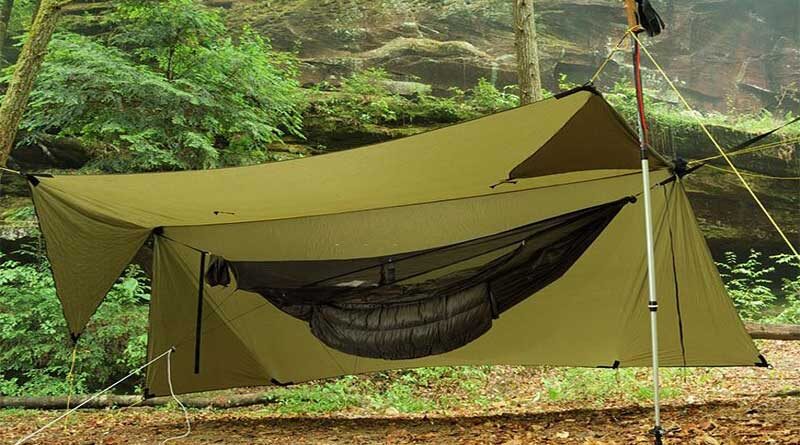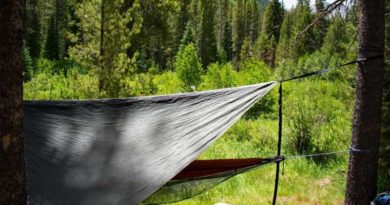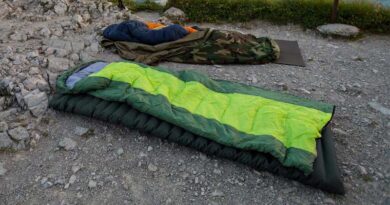Hammock Sleeping Pad Vs. Underquilt: Which is Better?
For those who love heading into the great outdoors, there’s often nothing better than sleeping under the stars. But you want to make sure that you’re going to be warm enough, especially as the weather starts turning colder. That’s where you might be wondering about two of the most popular methods of staying warm, sleeping pads and underquilts. But which one is the better way to go? Which will help you stay warm and comfortable no matter what the temperatures are like outside? Let’s take a closer look.
Many people love sleeping in a hammock outside because it gives them the chance to enjoy the great outdoors. For some, this is an activity that they do during the daytime, but some like to do it at night and that’s when you’re going to need either a pad or an underquilt, but which one?
Hammock Sleeping Pad
A hammock sleeping pad is a closed-cell, inflatable pad or a foam pad that fits directly into the bottom of your hammock. You would stick it down into the bottom of the hammock firmly and then you sleep on top of it with your sleeping bag, blankets, or whatever else you’re using. The idea is that it provides another layer of insulation to help you stay warmer.
A sleeping pad has a number of benefits, namely that it’s extremely versatile. If you’re planning to sleep in a hammock and end up sleeping on the ground, for example, you can still use your sleeping pad. It’s going to still provide you with insulation against the cold.
These pads are also lightweight, which makes them easy to take with you wherever you want to go, and they’re inexpensive, which makes them a great and easy investment for just about any camper. Not to mention you can get it inflated to just the level that you want.
The downside with these hammock pads, however, is that they often tend to move around. When you move around it’s likely to slide, which makes hammock camping uncomfortable.
Another thing to keep in mind is the warmth. You won’t get quite as much warmth with this type of sleeping pad as you will with an underquilt, which means that it’s not the best option for those who plan to head out in the most extreme of weather.
Klymit Hammock V: Best Pad Option

Type: Air Pad
Shape: Semi-rectangular
Insulated: Yes
R-Value: 4.4
Weight: 2 lbs. 4 oz.
The Klymit Hammock V Sleeping Pad keeps you warm and comfortable in your hammock by adding an insulating layer between you and the cold air underneath. The hammock V is created specifically with hammocks in mind. With noticeable wings on the side, these are here to keep your hammock out of your face as you sleep and it will expand your hammock for greater comfort. Sleeping with a pad and a hammock might seem redundant but any experienced hammock camper will tell you that cold air passing underneath you can chill you even if you’re in a sleeping bag; not with the hammock V.
The layer between you and the cold air below is enough to make this a 3-season pad. Normally, you need to sleep diagonally in a hammock to flatten the material and to prevent your back from arching, which can get painful. This pad does a lot to prevent that by giving you a flatter surface while you sleep.
The unique V design to the baffles makes this pad an even better choice for comfort. I found that the pivot point to the flaps and the main pad embrace the hammock shape. On the back and the front, the Hammock V has grippy areas that are designed to keep the pad in place even if you toss and turn at night. Inflating the pad takes me approximately 15 to 20 breaths of air. When it’s deflated and packed up, it’s about the size of a large water bottle and weighs 27 ounces. That’s small and light enough to include with your hammock system and still have room to spare in your pack.
I’ve been hammock camping for years and have always been turned away by using a pad that will move around at night and won’t fit my hammock. This pad has me rethinking how I sleep in the backcountry.
What I like: Versatile, works for both ground and hammock sleeping
What I don’t: A little heavy for an inflatable pad.
Underquilt
Another option to help you stay warm in a hammock is an underquilt. Basically, this looks like a sleeping bag in many ways. It’s only a single layer or quilt. You put it under the hammock rather than under yourself, because it’s made up of very tiny fibers. It then holds the warm air of your body heat and pushes it back up through the bottom of the hammock to you.
This type of insulation has many benefits. For one thing, it’s very comfortable because you’re actually sleeping on the hammock and you won’t even notice the underquilt. It’s not going to be touching you in any way, which means you get all the normal benefits from your hammock.
Also, you don’t have to worry about getting too cold because underquilts are designed to provide you with plenty of heat. For those who like even the most extreme weather, these quilts can provide you with plenty of insulation because you’re not crushing them when you sleep, unlike sleeping pads that only have a small amount of loft.
On the other hand, there are some downsides to these quilts that you’ll need to keep in mind. An underquilt is a little more expensive than a sleeping pad and it’s going to weigh a little more too. That can be difficult when you’re just getting started and when you need to transport it. Not to mention they tend to be bulkier than sleeping pads.
Attaching the underquilt can be a bit difficult as well since you need it under the hammock but you don’t want to crush the loft too much. If you don’t have a hammock with a pocket in it to hold an underquilt you’ll be trying to rig something up on your own.
ENO Vulcan: Best Quilt Option

Insulated: Yes
Temperature Rating: 30-45°F
Materials: 20D Ripstop Nylon
Dimensions: 82 x 48 inches
Weight: 1 lb. 13 oz.
An underquilt is crucial to keeping you warm when sleeping in a hammock on a cold night. The Vulcan provides 2 layers of high-performance Primaloft insulation that is enough to keep you warm in temperatures as cold as 30°F. The Vulcan underquilt uses synthetic insulation with a water-resistant shell for complete protection. Unlike the traditional sleeping bags (which compress when you lay on them), this quilt hangs underneath your hammock and it’s going to provide all that warmth regardless of your body weight. There are stretchy drawcords at both ends that can be used to hang it. These drawcords are adjustable so you can adjust them right exactly where you need them.
The underquilt is about 6 feet and 10 inches long when fully stretched and about 4 feet wide. You get enough coverage with this quilt from head to toe. The quilt packs down super small and it weighs around 1.75 pounds. It does come with a small nylon stuff sack that can be used to compress it for packing in a backpack. The temperature rating is here around 30 to 45°F and it is advisable that you pair it with some sort of top quilt, sleeping bag, or something that’s going to insulate from the top.
What I like: Very warm, no cold spots, does not compress with the bodyweight
What I don’t: Slip a bit in the middle of the night.
Hammock Sleeping Pad Vs. Underquilt: A Comparison
| FEATURE | HAMMOCK SLEEPING PAD | UNDERQUILT |
|---|---|---|
| Cost | Affordable | High-end quilts are quite expensive |
| Versatility | Can be used in different situations | No very versatile |
| Choose Your Inflation | Can be inflated to your desired firmness | No an option |
| Lightweight | A variety of options available | Quilts are usually lightweight |
| Slides During Use | A sleeping pad can slide during night | Does not slide too often |
| Warmest Choice | Not very warm | A quilt can be the warmest choice |
| Bulky to Carry | Depends on the type of pad | Quits compress to a small size |
What else is there?
It’s important to think about what else you’re going to need when you’re out sleeping in a hammock for those cold nights. You shouldn’t rely on just the underquilt or the sleeping pad to keep you warm. Instead, make sure that you also have a sleeping bag or a blanket. If the temperature is cold enough you may want to have both to make sure that you’re warm enough. Emergency blankets are another option that is slightly different from your standard blanket, but they’ll keep you warmer.
If you’re thinking about winter camping, consider each of these options. But remember that they are going to be up to your personal preference. Both will keep you warm, though in slightly different ways. Both will help you enjoy your night outdoors. Just make sure you pick the style of insulation that you’re most comfortable with.
Remember, the key to sleeping outdoors is to find a way to stay comfortable and really enjoy the experience. Being cold is definitely not going to help with that so choose an underquilt or a hammock sleeping pad before you head out and make sure that you’re getting the most out of this experience. You might find that you want to repeat it again and again once you’ve figured out the best insulation method.




